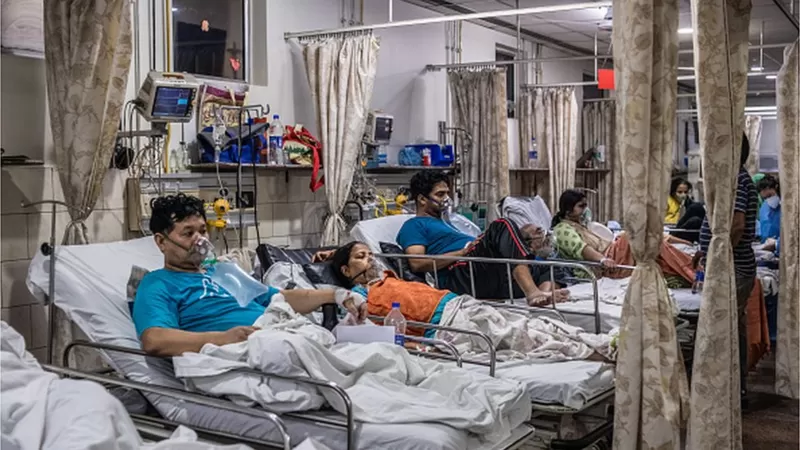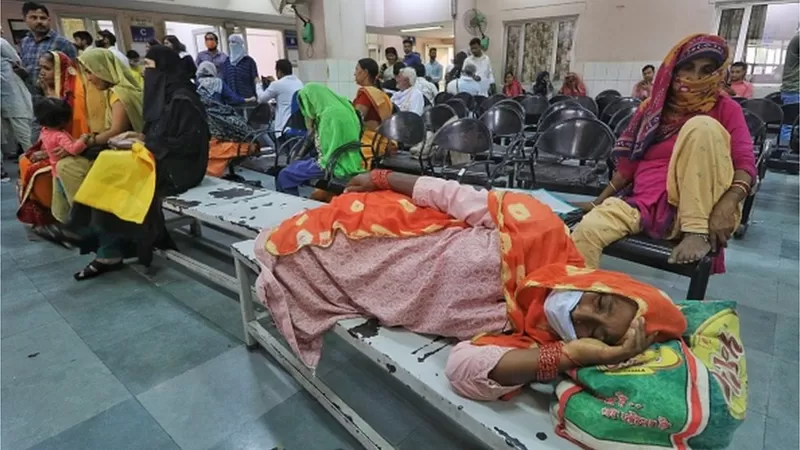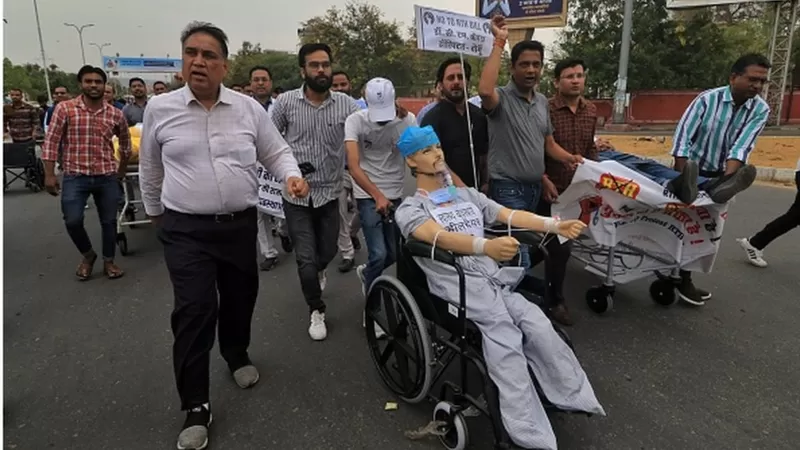[ad_1]
For two weeks recently, tens of thousands of private doctors in Rajasthan protested against a landmark bill which guarantees a right to health for the northern Indian state’s 80 million people.
The protests crippled private healthcare services and public hospitals were overwhelmed by patients. On Tuesday, the state government said it had reached an agreement with the doctors, prompting them to call off the strike.
What had raised the hackles of the protesters was a provision in the law that made it mandatory for public and private hospitals to offer emergency treatment to people, the costs of which would be later reimbursed by the government. The doctors said there was no clarity on how and where this money would come from.
A number of India’s states have their own health insurance programmes that entitle low-income households to free health care at state-run and listed private hospitals. A federal health insurance programme called PM-JAY was launched in 2018 to cover the poorest 40% of people. The Supreme Court has held that denial of emergency medical care was a constitutional violation of right to life.
Yet public health in India remains patchy and underfunded, grappling with shortages of money, doctors and nurses. India spends a little over 2% of its GDP on public healthcare, one of the lowest in the world. Most people have to pay around half of healthcare spending – especially medicines – out of their own pocket.
Private doctors, clinics and hospitals mop up some 80% of the total healthcare spending. More than 55 million people are pushed back into poverty every year because of “catastrophic” health expenses, which affect some 17% of households, according to a WHO report.

Not surprisingly, price-setting and reimbursements lie at the heart of a state-run public health insurance programme or a law giving people the right to health. Both are tricky.
An operation, for example, in a high-end hospital could cost six times more than in a nursing home. If the government opted for the cheaper rate, private hospitals were likely to turn away patients seeking surgery under the programme or ask them to pay the balance. If the government opted for the higher rate, the costs of the programme would escalate tremendously.
“How you price and manage reimbursements is a big part of getting private sector into play,” Prof Jishnu Das of Georgetown University told me.
These concerns were starkly underlined in a study by Radhika Jain of University College, London, on how reimbursement rates or prices affect the behaviour of private hospitals and performance of a state-run health insurance programme in India.
Prof Jain looked at more than 1.6 million claims and 20,000 patients in an existing state-run public health insurance programme in Rajasthan that reimburses hospitals at a specified, fixed rate per service covering tests, medicines and hospital costs.
She found that private hospitals were engaged in filing claims for higher priced and reimbursed services than those actually provided and charged patients for care that should be free under the programme, among other things. This suggested that “weak oversight and profit-motivated private agents are systematically flouting programme rules to increase their revenues at the expense of the government and patients”.

On the other hand, the protesting private doctors in Rajasthan also had a few points. For one, how do you define an emergency service for which the state would pay? “It could range from a heart attack to a delivery to a child coming in with a stomach ache,” a doctor told a newspaper.
Second, how do you identify hospitals which can provide emergency care? (One study estimates that 65% of India’s private hospitals are small facilities with 11-50 beds.) After the protests, the state government agreed to exclude from the ambit of the bill private hospitals with fewer than 50 beds and those who had not used government concessions to set up their facilities.
With these exceptions, at least “98% of private hospitals” in Rajasthan would not be part of the law, according to Dr Sunil Chugh, a senior functionary of an association of doctors.
If true, that would be quite significant. Rajasthan’s government says the new law will prod it to improve and upgrade public health, which would be welcomed by all. But as Prof Jain’s study showed, making people trust state-run health facilities will take time – 75% of the insurance claims in the first four years of the Rajasthan programme were from private hospitals.
The plight of Surendra Meghwal, a 44-year-old resident of Rajasthan, also tells the story of the yawning gap between promises and reality. He’s still paying off medical debt that he incurred in treating his sister-in-law who died of Covid two years ago at a private hospital in Karauli district. The family had taken the patient to the private facility because there were no beds available in the public hospital.

Mr Meghwal said people in villages had to rush to small multi-speciality private hospitals in districts during health emergencies because there were not enough public health facilities. “If the government now exempts these small hospitals from the right to health, where will we go? We will keep suffering,” he said.
A new law means courts and hefty regulation would come into the picture, says Prof Das. (He cited the case of Colombia where affluent people were clogging the courts seeking expensive treatments under the right to health law.) He reckons Rajasthan alone would need 6,000 regulators to look at healthcare claims, fraud, legal disputes, customer complaints and analysing data.
“The good thing about the bill is it says we still want to keep investing in public healthcare, but the unspoken part of it is that people have the option of going to the private sector,” he said.
Public health advocacy groups believe Rajasthan needs India’s first right-to-health bill. A 2021 report on “healthy states” by Niti Aayog, a think-tank, India’s federal health ministry and the World Bank placed it 16th among 19 big states. It has high rates of infant mortality – deaths of children under one year. It also has a worryingly low number of doctors compared to its population.
But an efficient right to health needs to “become a daily, lived reality” for the people, Prof Jain told me. The definition and details of what comprises an emergency, provisions around emergency care at private hospitals, and payment rates will have to be ironed out.
The government would need to shore up public health facilities and improve the range and quality of healthcare they offer. “This actually puts a lot of the onus on the state to do the hard work of financing, implementation, oversight, and enforcement that is yet to come,” she said.
Back in Rajasthan, Chhaya Pachauli of Jan Swasthya Abhiyan, a health rights group, hoped that the law would “prove to be a changemaker for the state and set an example for other Indian states to take a cue”. Nobody would begrudge that.
DISCLAIMER: The Views, Comments, Opinions, Contributions and Statements made by Readers and Contributors on this platform do not necessarily represent the views or policy of Multimedia Group Limited.
[ad_2]
Source link